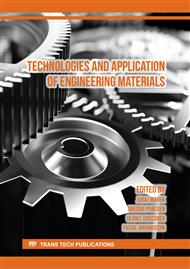[1]
J. António, A. Tadeu, B. Marques, J. A. S. Almeida, and V. Pinto, "Application of rice husk in the development of new composite boards," Constr. Build. Mater. 176 (2018) 432–439.
DOI: 10.1016/j.conbuildmat.2018.05.028
Google Scholar
[2]
C. Buratti, E. Belloni, E. Lascaro, F. Merli, and P. Ricciardi, "Rice husk panels for building applications: Thermal, acoustic and environmental characterization and comparison with other innovative recycled waste materials," Constr. Build. Mater. 171 (2018) 338–349.
DOI: 10.1016/j.conbuildmat.2018.03.089
Google Scholar
[3]
H. Ummah, D. A. Suriamihardja, M. Selintung, and A. W. Wahab, "Analisis Sekam Padi Menggunakan SEM Sebagai Pelat Absorber Air LAut Menjadi Air Bersih," J. Sains Teknol. 3 (2014) 135–141.
Google Scholar
[4]
Y. Yuliah, S. Suryaningsih, and K. Ulfi, "Penentuan Kadar Air Hilang dan Volatile Matter pada Bio-briket dari Campuran Arang Sekam Padi dan Batok Kelapa," J. Ilmu dan Inov. Fis. 1 (2017) 51–57.
DOI: 10.24198/jiif.v1i01.10902
Google Scholar
[5]
M. Amran et al., "Rice husk ash‐based concrete composites: A critical review of their properties and applications," Crystals. 11 (2021) 1–33.
Google Scholar
[6]
A. Saidah, S. E. Susilowati, Harini, and Y. Nofendri, "Analisa Perbandingan Kekuatan Tarik Dan Impak Komposit Serat Jerami Padi Polyester Dengan Komposit Serat Jerami Padi Epoxy Dengan Metode Hand Lay Up," Pros. Semin. Nas. Apl. Sains Teknol. (2018) p.291–298.
DOI: 10.21009/jkem.5.2.7
Google Scholar
[7]
Fauziah, D. Wahyuni, and B. P. Lapanporo, "Analisis Sifat Fisik dan Mekanik Papan Partikel Berbahan Dasar Sekam Padi," Positron, 4 (2014) 60–63.
DOI: 10.26418/positron.v4i2.8728
Google Scholar
[8]
L. Axelsson, M. Franzén, M. Ostwald, G. Berndes, G. Lakshmi, and N. H. Ravindranath, "Perspective: Jatropha cultivation in southern India: Assessing farmers' experiences," Biofuels, Bioprod. Biorefining. 6 (2012) 246–256.
DOI: 10.1002/bbb.1324
Google Scholar
[9]
Eryani, S. Aprilia, and F. Mulana, "Karakterisasi Bionanofiller Dari Limbah Padi Sebagai Alternatif Penguatan Pada Polimer Komposit," J. Serambi Eng. 3 (2018) 338–347.
DOI: 10.32672/jse.v3i2.717
Google Scholar
[10]
L. Cao, Q. Fu, Y. Si, B. Ding, and J. Yu, "Porous materials for sound absorption," Compos. Commun. 10 (2018) 25–35.
Google Scholar
[11]
E. Rusmawati, "Penentuan Koefisien Absorbsi Dengan Metode Dua Mikrofon Pada Tabung Impedansi.". J. Teknik Fisika FTI - ITS 1 (2000) 1–4 .
DOI: 10.25077/jif.7.2.56-62.2015
Google Scholar
[12]
H. Qui and Y. Enhui, "Effect of Thickness, Density and Cavity Depth on the Sound Absorption Properties of Wool Boards," Autex Res. J. 18 (2018) 203–208.
DOI: 10.1515/aut-2017-0020
Google Scholar
[13]
B. Marques et al., "Rice husk cement-based composites for acoustic barriers and thermal insulating layers," J. Build. Eng. 39, (2021) p.2020.
Google Scholar
[14]
D. T. Tran et al., "Green aerogels from rice straw for thermal, acoustic insulation and oil spill cleaning applications," Mater. Chem. Phys. 253 (2020) p.123363.
DOI: 10.1016/j.matchemphys.2020.123363
Google Scholar
[15]
B. Marques et al., "Vibro-acoustic behaviour of polymer-based composite materials produced with rice husk and recycled rubber granules," Constr. Build. Mater. 264 (2020) p.120221.
DOI: 10.1016/j.conbuildmat.2020.120221
Google Scholar
[16]
M. N. R. T. H. Ningsih, "Penggunaan Serat Jerami Padi Dalam Pembuatan Material Komposit Sebagai Alternatif Bahan Bumper Mobil," J. Teknik Mesin 9 (2021) 1–6.
DOI: 10.15294/jkomtek.v12i2.23329
Google Scholar
[17]
ASTM E 1050, "Standard test method for impedance and absorption of acoustical materials using a tube, two microphones and a digital frequency analysis system," Am. Soc. Test. Mater., no. C, 1998, p.1–12.
DOI: 10.1520/e1050-10
Google Scholar
[18]
C. Novak, H. Ule, and J. Kunio, "Comparative Study of the ASTM E1050 Standard for Different Impedance Tube Lengths," Noise-Con 2011, p.9, (2011).
Google Scholar
[19]
D. C. Çelikel and O. Babaarslan, "Effect of bicomponent fibers on sound absorption properties of multilayer nonwovens," J. Eng. Fiber. Fabr. 12 (2017) 15–25.
DOI: 10.1177/155892501701200403
Google Scholar
[20]
N. Neithalath, A. Marolf, J. Weiss, and J. Olek, "Modeling the influence of pore structure on the acoustic absorption of enhanced porosity concrete" J. Adv. Concr. Technol.3(2005)29–40.
DOI: 10.3151/jact.3.29
Google Scholar



